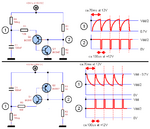Michael Weaser
Member level 3
I am trying to have an old tube based relaxation oscillator circuit converted to a modern circuit. This circuit has the ability to be controlled using a pitch pedal ( also a potentiometer ) and with 2 potentiometers . the potentiometer on the left of the pedal changes the range of the pedal , than the one on the right changes the grid bias of the tube which changes what the relaxation oscillator sounds like. I know how to make a relaxation oscillator circuit, but don't understand how the other components would be added to a modern relaxation oscillator circuit.




![thN2y[1].png thN2y[1].png](https://www.edaboard.com/data/attachments/94/94330-ceee7b3d07732ad070cab24d2610eabf.jpg)